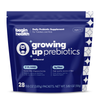Halloween Sugar Chart: How Much Sugar is in Your Kid’s Candy?
share this article

One of the most rewarding things about being a Registered Dietitian is being able to help parents make informed choices for their kids’ health. With Halloween and the upcoming holiday season around the corner, it's a good time to remind parents of the impact of excessive sugar intake in your little ones.
While an occasional treat is totally fine, excessive added sugar in the diet can impact not only your little one’s gut health, but their overall health too. Let’s review the sugar content in common popular candies and what the research says about added sugar in our kiddo’s diets.
Hidden Sugars in Halloween Candy
Halloween is synonymous with candy and treats, but it can also be an easy time for kids to consume sugar in excess. Many popular Halloween candies are loaded with added sugars that far exceed the recommended daily limits. For instance, a standard fun-sized candy bar often contains between 8 to 12 grams of sugar, and kids can easily consume several of these in a single night. The American Heart Association advises that kids aged 2 years and up should consume no more than 25 grams (about 6 teaspoons) of added sugar per day.
Daily reads to help your little ones lead happier and healthier lives.
Join the
Happy Gut Club
Research has shown that excessive sugar intake is associated with various health concerns, such as:
-
Obesity: A high-sugar diet can contribute to weight gain and childhood obesity. It is estimated that around 124 million children and adolescents aged 5–19 years old are classified as obese and 213 million as overweight in 2017. These numbers rank childhood obesity as one of the major public health issues of the 21st century [1].
-
Dental Issues: Excess added sugars, particularly in the form of sugar sweetened beverages, is a leading cause of tooth decay in U.S. children [2].
-
Chronic Diseases: Excessive sugar consumption can raise the risk of developing chronic diseases like type 2 diabetes and heart disease. Childhood obesity is also associated with premature onset of disease risk factors such as hypertension, dyslipidemia, insulin resistance, and glucose intolerance [1].
Sugar Content in Common Halloween Candies
|
Candy Type |
Sugar Content Per Serving |
Percent (%) of Daily Added Sugar Intake for Kids (ages 2 years and up) |
|---|---|---|
|
Fun-sized candy bar (1 piece) |
8-12 grams |
32-48% |
|
Gummy Bears (10 pieces) |
11 grams |
44% |
|
Fruit Chewy Candy (1 individual sized pack) |
15 grams |
60% |
|
Candy Corn (19 pieces) |
19 grams |
76% |
|
Chocolate covered candies (2 pieces) |
10-20 grams |
40-80% |
|
Lollipops (1 lollipop) |
10 grams |
40% |
The Benefits of Reducing Added Sugar Intake in Kids
Reducing sugar intake can have a significant positive impact on your kid’s health:
-
Healthy Weight Management: A lower sugar intake can help maintain a healthy weight, which is crucial for overall well-being [3].
-
Stable Energy Levels: Reducing added sugar intake can prevent energy spikes and crashes, which helps your kids stay energized throughout the day.
-
Improved Dental Health: Reducing sugar decreases the risk of cavities and dental problems [2].
-
Better Focus: A diet that’s low in added sugars can lead to improved concentration and behavior in school-aged children. Research literature on sugar consumption suggested that a higher consumption of sugar is positively correlated with a higher level of hyperactivity and attention deficiency similar to ADHD [4].
-
Lower Risk of Chronic Diseases: By reducing sugar intake, you can help lower the risk of developing conditions like type 2 diabetes and heart disease [1].
Alternatives to Candy for Halloween Night
Finding alternatives to traditional candy for kids on Halloween can make the holiday both fun and better for their health. Here are some creative, non-candy related treat options:
-
Glow-in-the-Dark Bracelets: Kids often love glow-in-the-dark bracelets, which can add an extra element of fun to their Halloween experience.
-
Halloween-Themed Toys: Consider Halloween-themed toys, like rubber spiders, bouncing balls, or mini puzzles that fit the holiday theme.
-
Stickers and Temporary Tattoos: Sheets of stickers or temporary tattoos featuring Halloween themes can be a hit with kids and are entirely sugar-free.
-
Bubbles: Mini bottles of bubbles can provide hours of entertainment and are a delightful alternative to sugary treats.
-
Fruit Snacks: Offer small packages of fruit snacks made from 100% real fruit juice and without added sugars or artificial flavors.
-
Fruit Cups: Single-serving fruit cups with no added sugars or syrups can be a refreshing and healthy alternative.
- Mini Water Bottles: Stay hydrated on the trick-or-treat route by handing out mini water bottles with Halloween themed stickers.
Summary
This Halloween, consider making more conscious choices for your kid’s health. The American Heart Association advises that kids aged 2 years and up should consume no more than 25 grams (about 6 teaspoons) of added sugar per day. While an occasional treat is fine, let’s be mindful of their overall added sugar intake on a daily basis so they can have stable energy levels, a healthier weight, and better gut health.


















